BMP4005 Business Management: Information Systems and Big Data Analysis
VerifiedAdded on 2023/06/13
|6
|1816
|349
Report
AI Summary
This report provides a comprehensive analysis of big data in business management, focusing on its characteristics, challenges, and available analytical techniques. It highlights how big data technology can support businesses through enhanced consumer dialogue, product redevelopment, and improved data safety, providing relevant examples. The report concludes that big data analytics is beneficial for business organizations, offering advantages over traditional data collection methods. Desklib provides access to this and other solved assignments for students.
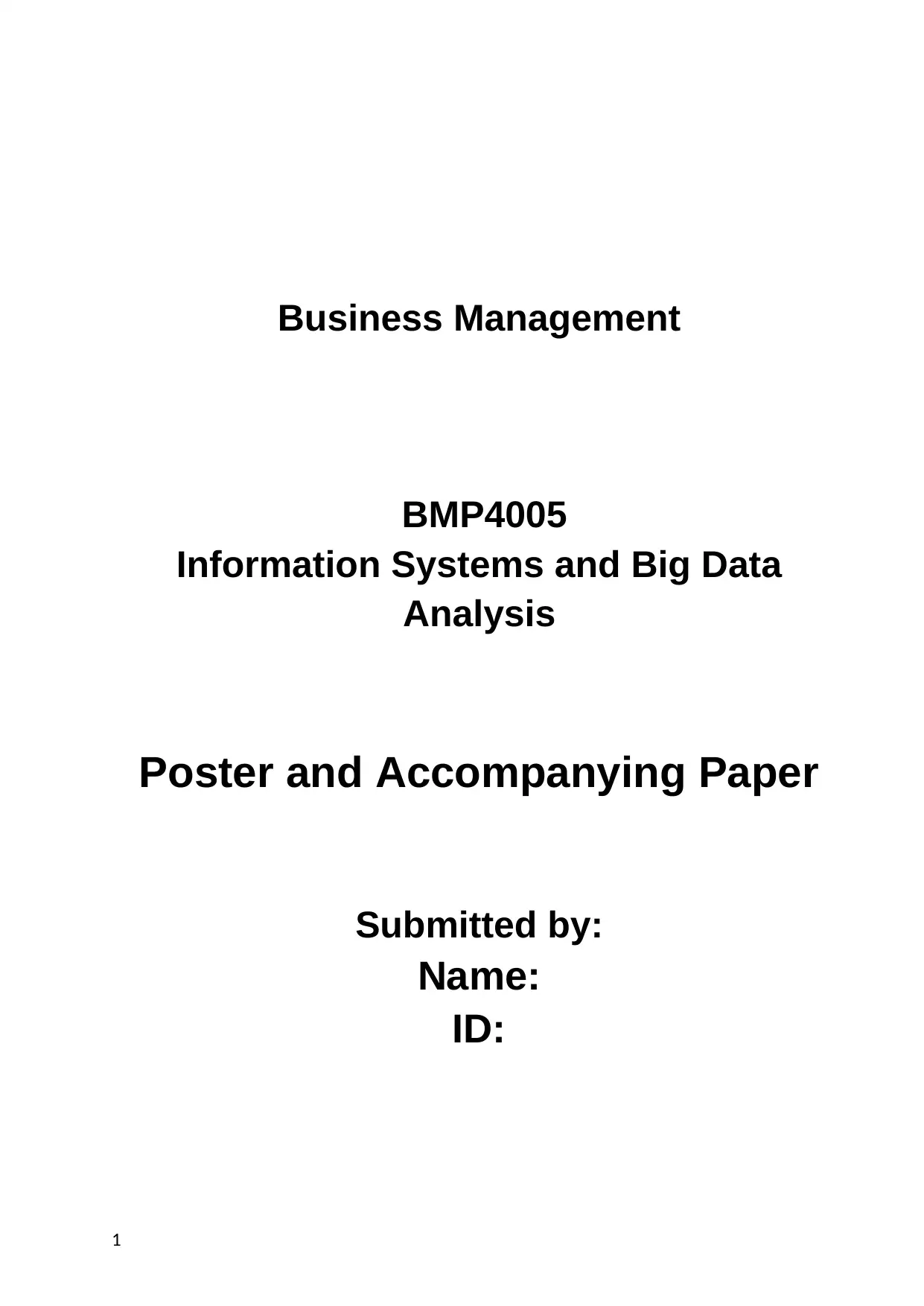
Business Management
BMP4005
Information Systems and Big Data
Analysis
Poster and Accompanying Paper
Submitted by:
Name:
ID:
1
BMP4005
Information Systems and Big Data
Analysis
Poster and Accompanying Paper
Submitted by:
Name:
ID:
1
Paraphrase This Document
Need a fresh take? Get an instant paraphrase of this document with our AI Paraphraser
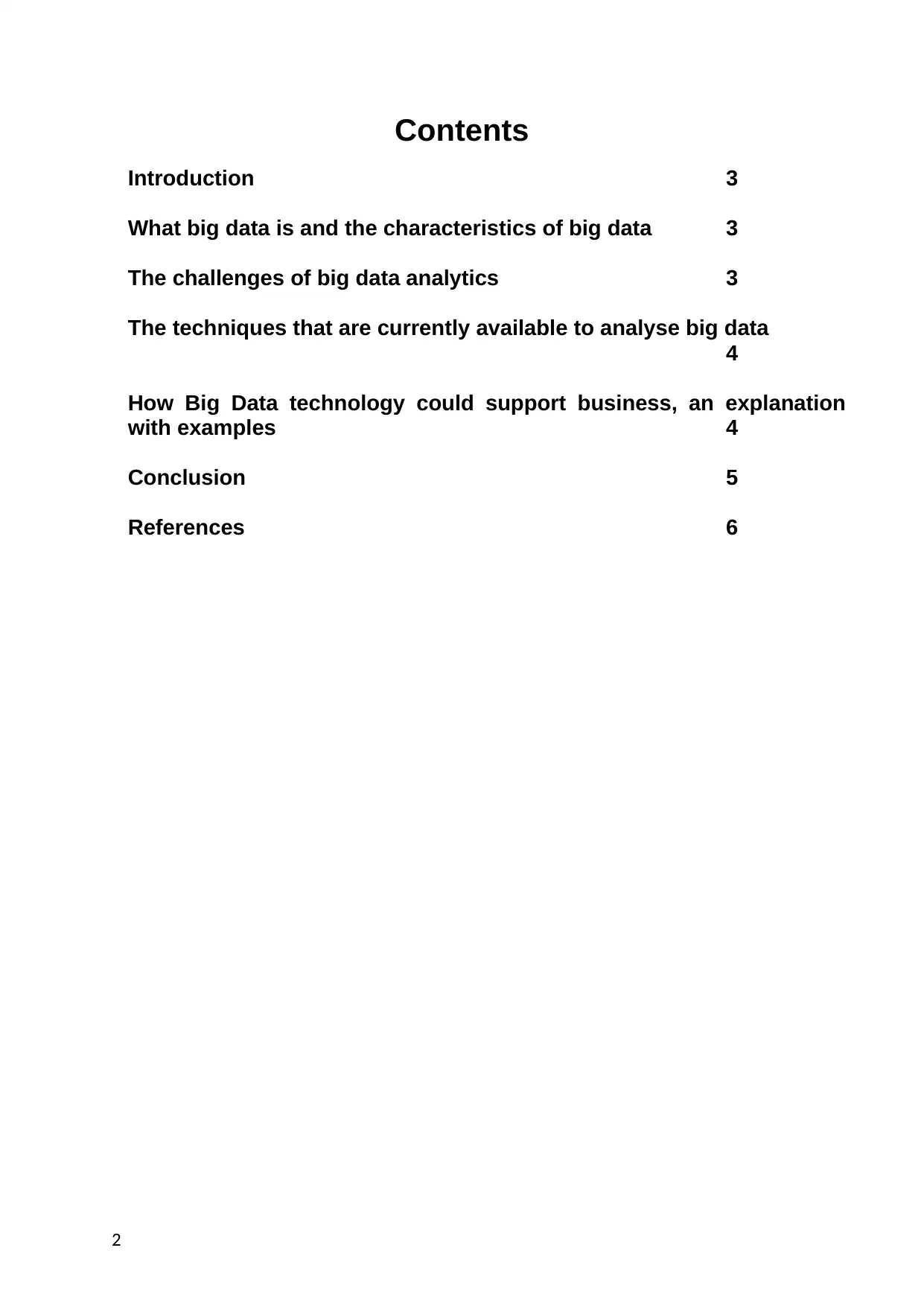
Contents
Introduction 3
What big data is and the characteristics of big data 3
The challenges of big data analytics 3
The techniques that are currently available to analyse big data
4
How Big Data technology could support business, an explanation
with examples 4
Conclusion 5
References 6
2
Introduction 3
What big data is and the characteristics of big data 3
The challenges of big data analytics 3
The techniques that are currently available to analyse big data
4
How Big Data technology could support business, an explanation
with examples 4
Conclusion 5
References 6
2
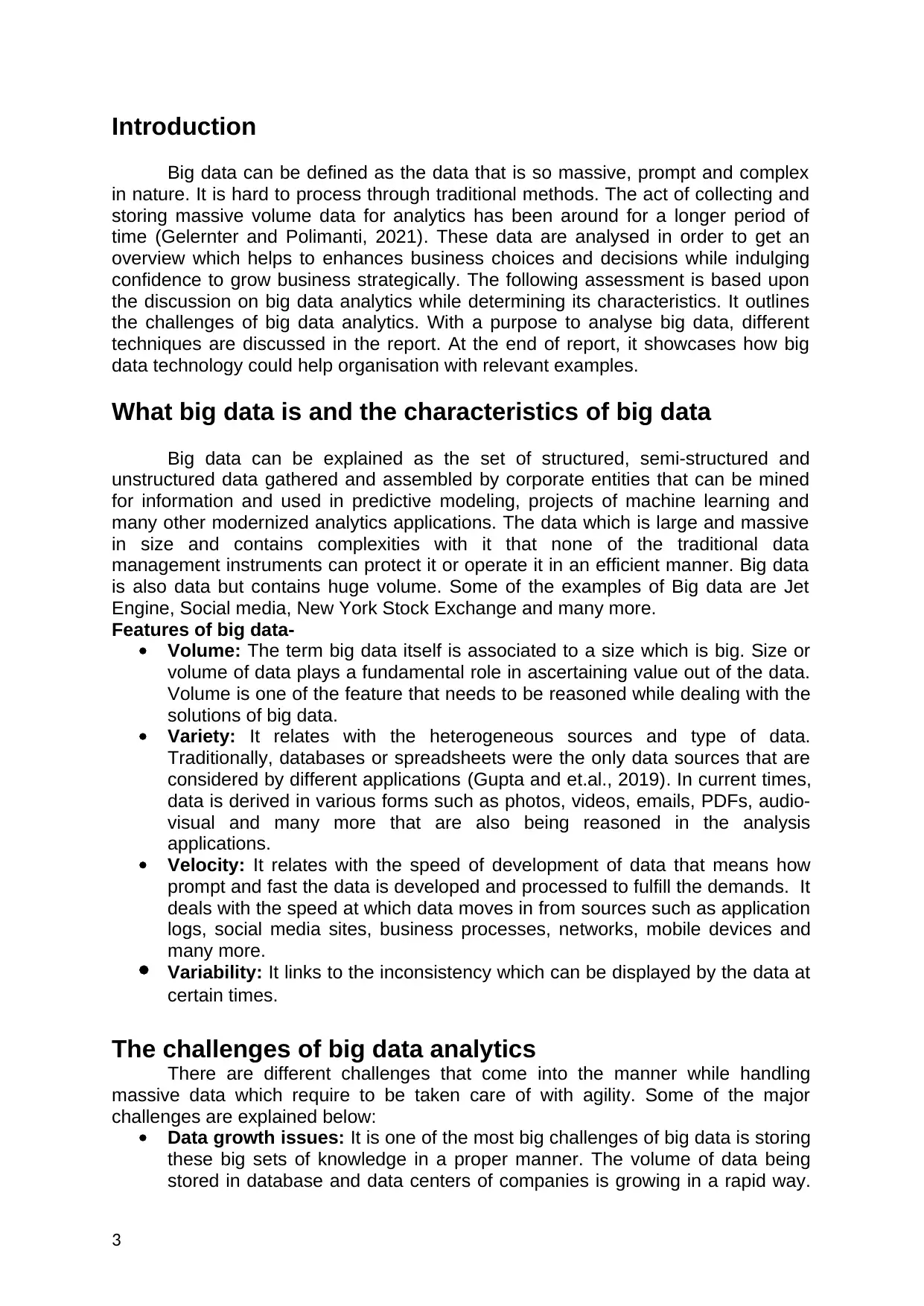
Introduction
Big data can be defined as the data that is so massive, prompt and complex
in nature. It is hard to process through traditional methods. The act of collecting and
storing massive volume data for analytics has been around for a longer period of
time (Gelernter and Polimanti, 2021). These data are analysed in order to get an
overview which helps to enhances business choices and decisions while indulging
confidence to grow business strategically. The following assessment is based upon
the discussion on big data analytics while determining its characteristics. It outlines
the challenges of big data analytics. With a purpose to analyse big data, different
techniques are discussed in the report. At the end of report, it showcases how big
data technology could help organisation with relevant examples.
What big data is and the characteristics of big data
Big data can be explained as the set of structured, semi-structured and
unstructured data gathered and assembled by corporate entities that can be mined
for information and used in predictive modeling, projects of machine learning and
many other modernized analytics applications. The data which is large and massive
in size and contains complexities with it that none of the traditional data
management instruments can protect it or operate it in an efficient manner. Big data
is also data but contains huge volume. Some of the examples of Big data are Jet
Engine, Social media, New York Stock Exchange and many more.
Features of big data-
Volume: The term big data itself is associated to a size which is big. Size or
volume of data plays a fundamental role in ascertaining value out of the data.
Volume is one of the feature that needs to be reasoned while dealing with the
solutions of big data.
Variety: It relates with the heterogeneous sources and type of data.
Traditionally, databases or spreadsheets were the only data sources that are
considered by different applications (Gupta and et.al., 2019). In current times,
data is derived in various forms such as photos, videos, emails, PDFs, audio-
visual and many more that are also being reasoned in the analysis
applications.
Velocity: It relates with the speed of development of data that means how
prompt and fast the data is developed and processed to fulfill the demands. It
deals with the speed at which data moves in from sources such as application
logs, social media sites, business processes, networks, mobile devices and
many more.
Variability: It links to the inconsistency which can be displayed by the data at
certain times.
The challenges of big data analytics
There are different challenges that come into the manner while handling
massive data which require to be taken care of with agility. Some of the major
challenges are explained below:
Data growth issues: It is one of the most big challenges of big data is storing
these big sets of knowledge in a proper manner. The volume of data being
stored in database and data centers of companies is growing in a rapid way.
3
Big data can be defined as the data that is so massive, prompt and complex
in nature. It is hard to process through traditional methods. The act of collecting and
storing massive volume data for analytics has been around for a longer period of
time (Gelernter and Polimanti, 2021). These data are analysed in order to get an
overview which helps to enhances business choices and decisions while indulging
confidence to grow business strategically. The following assessment is based upon
the discussion on big data analytics while determining its characteristics. It outlines
the challenges of big data analytics. With a purpose to analyse big data, different
techniques are discussed in the report. At the end of report, it showcases how big
data technology could help organisation with relevant examples.
What big data is and the characteristics of big data
Big data can be explained as the set of structured, semi-structured and
unstructured data gathered and assembled by corporate entities that can be mined
for information and used in predictive modeling, projects of machine learning and
many other modernized analytics applications. The data which is large and massive
in size and contains complexities with it that none of the traditional data
management instruments can protect it or operate it in an efficient manner. Big data
is also data but contains huge volume. Some of the examples of Big data are Jet
Engine, Social media, New York Stock Exchange and many more.
Features of big data-
Volume: The term big data itself is associated to a size which is big. Size or
volume of data plays a fundamental role in ascertaining value out of the data.
Volume is one of the feature that needs to be reasoned while dealing with the
solutions of big data.
Variety: It relates with the heterogeneous sources and type of data.
Traditionally, databases or spreadsheets were the only data sources that are
considered by different applications (Gupta and et.al., 2019). In current times,
data is derived in various forms such as photos, videos, emails, PDFs, audio-
visual and many more that are also being reasoned in the analysis
applications.
Velocity: It relates with the speed of development of data that means how
prompt and fast the data is developed and processed to fulfill the demands. It
deals with the speed at which data moves in from sources such as application
logs, social media sites, business processes, networks, mobile devices and
many more.
Variability: It links to the inconsistency which can be displayed by the data at
certain times.
The challenges of big data analytics
There are different challenges that come into the manner while handling
massive data which require to be taken care of with agility. Some of the major
challenges are explained below:
Data growth issues: It is one of the most big challenges of big data is storing
these big sets of knowledge in a proper manner. The volume of data being
stored in database and data centers of companies is growing in a rapid way.
3
⊘ This is a preview!⊘
Do you want full access?
Subscribe today to unlock all pages.

Trusted by 1+ million students worldwide
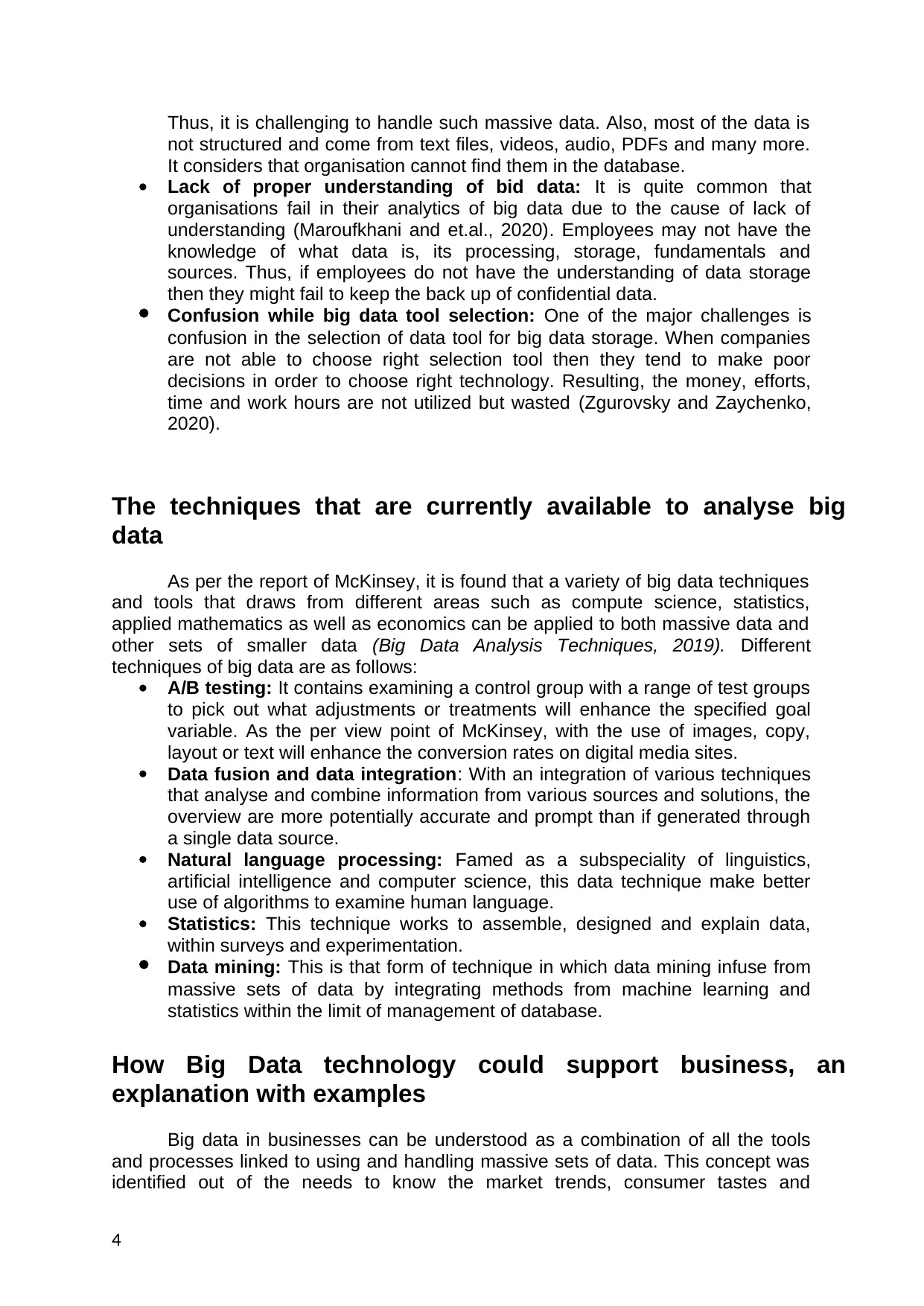
Thus, it is challenging to handle such massive data. Also, most of the data is
not structured and come from text files, videos, audio, PDFs and many more.
It considers that organisation cannot find them in the database.
Lack of proper understanding of bid data: It is quite common that
organisations fail in their analytics of big data due to the cause of lack of
understanding (Maroufkhani and et.al., 2020). Employees may not have the
knowledge of what data is, its processing, storage, fundamentals and
sources. Thus, if employees do not have the understanding of data storage
then they might fail to keep the back up of confidential data.
Confusion while big data tool selection: One of the major challenges is
confusion in the selection of data tool for big data storage. When companies
are not able to choose right selection tool then they tend to make poor
decisions in order to choose right technology. Resulting, the money, efforts,
time and work hours are not utilized but wasted (Zgurovsky and Zaychenko,
2020).
The techniques that are currently available to analyse big
data
As per the report of McKinsey, it is found that a variety of big data techniques
and tools that draws from different areas such as compute science, statistics,
applied mathematics as well as economics can be applied to both massive data and
other sets of smaller data (Big Data Analysis Techniques, 2019). Different
techniques of big data are as follows:
A/B testing: It contains examining a control group with a range of test groups
to pick out what adjustments or treatments will enhance the specified goal
variable. As the per view point of McKinsey, with the use of images, copy,
layout or text will enhance the conversion rates on digital media sites.
Data fusion and data integration: With an integration of various techniques
that analyse and combine information from various sources and solutions, the
overview are more potentially accurate and prompt than if generated through
a single data source.
Natural language processing: Famed as a subspeciality of linguistics,
artificial intelligence and computer science, this data technique make better
use of algorithms to examine human language.
Statistics: This technique works to assemble, designed and explain data,
within surveys and experimentation.
Data mining: This is that form of technique in which data mining infuse from
massive sets of data by integrating methods from machine learning and
statistics within the limit of management of database.
How Big Data technology could support business, an
explanation with examples
Big data in businesses can be understood as a combination of all the tools
and processes linked to using and handling massive sets of data. This concept was
identified out of the needs to know the market trends, consumer tastes and
4
not structured and come from text files, videos, audio, PDFs and many more.
It considers that organisation cannot find them in the database.
Lack of proper understanding of bid data: It is quite common that
organisations fail in their analytics of big data due to the cause of lack of
understanding (Maroufkhani and et.al., 2020). Employees may not have the
knowledge of what data is, its processing, storage, fundamentals and
sources. Thus, if employees do not have the understanding of data storage
then they might fail to keep the back up of confidential data.
Confusion while big data tool selection: One of the major challenges is
confusion in the selection of data tool for big data storage. When companies
are not able to choose right selection tool then they tend to make poor
decisions in order to choose right technology. Resulting, the money, efforts,
time and work hours are not utilized but wasted (Zgurovsky and Zaychenko,
2020).
The techniques that are currently available to analyse big
data
As per the report of McKinsey, it is found that a variety of big data techniques
and tools that draws from different areas such as compute science, statistics,
applied mathematics as well as economics can be applied to both massive data and
other sets of smaller data (Big Data Analysis Techniques, 2019). Different
techniques of big data are as follows:
A/B testing: It contains examining a control group with a range of test groups
to pick out what adjustments or treatments will enhance the specified goal
variable. As the per view point of McKinsey, with the use of images, copy,
layout or text will enhance the conversion rates on digital media sites.
Data fusion and data integration: With an integration of various techniques
that analyse and combine information from various sources and solutions, the
overview are more potentially accurate and prompt than if generated through
a single data source.
Natural language processing: Famed as a subspeciality of linguistics,
artificial intelligence and computer science, this data technique make better
use of algorithms to examine human language.
Statistics: This technique works to assemble, designed and explain data,
within surveys and experimentation.
Data mining: This is that form of technique in which data mining infuse from
massive sets of data by integrating methods from machine learning and
statistics within the limit of management of database.
How Big Data technology could support business, an
explanation with examples
Big data in businesses can be understood as a combination of all the tools
and processes linked to using and handling massive sets of data. This concept was
identified out of the needs to know the market trends, consumer tastes and
4
Paraphrase This Document
Need a fresh take? Get an instant paraphrase of this document with our AI Paraphraser
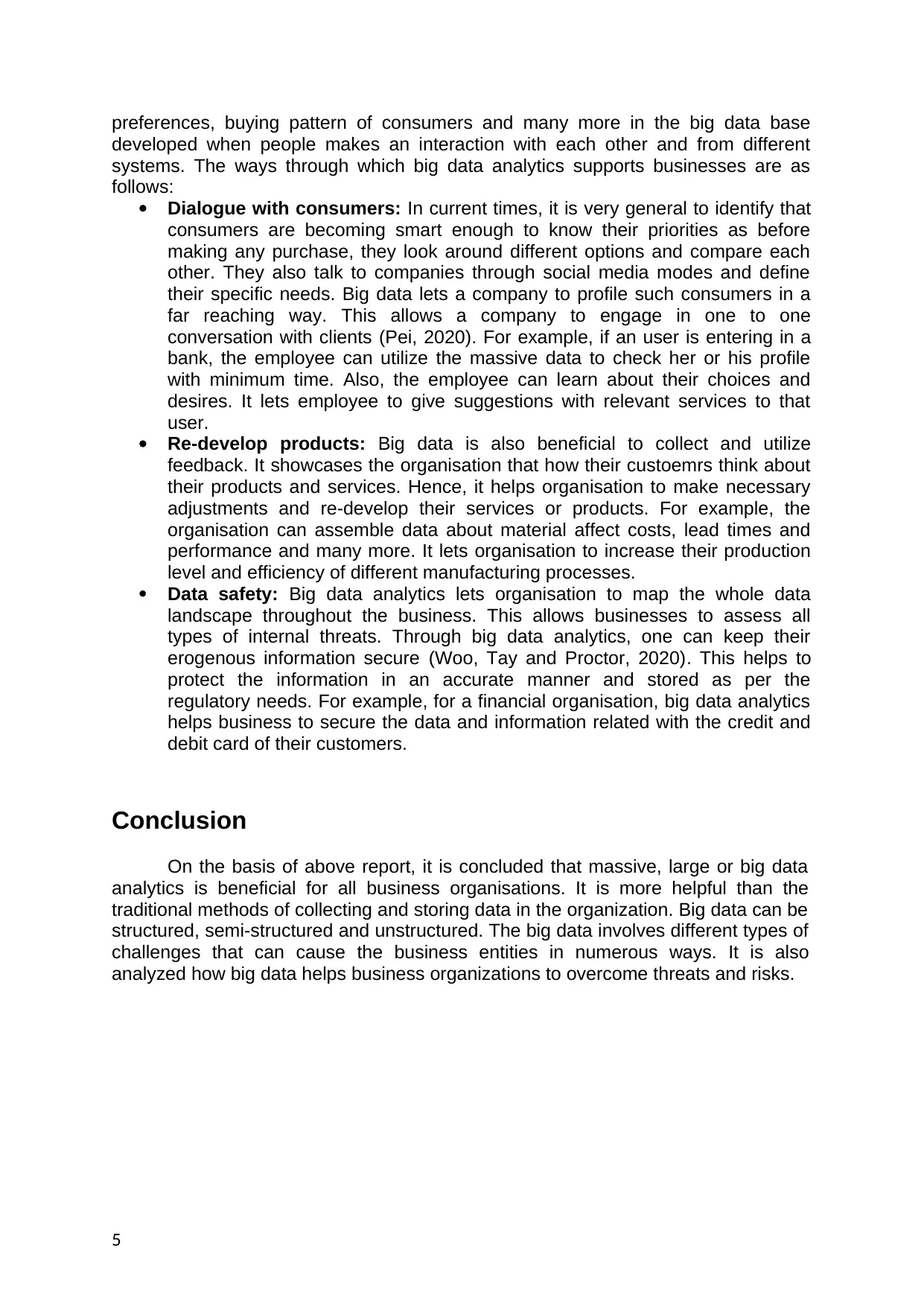
preferences, buying pattern of consumers and many more in the big data base
developed when people makes an interaction with each other and from different
systems. The ways through which big data analytics supports businesses are as
follows:
Dialogue with consumers: In current times, it is very general to identify that
consumers are becoming smart enough to know their priorities as before
making any purchase, they look around different options and compare each
other. They also talk to companies through social media modes and define
their specific needs. Big data lets a company to profile such consumers in a
far reaching way. This allows a company to engage in one to one
conversation with clients (Pei, 2020). For example, if an user is entering in a
bank, the employee can utilize the massive data to check her or his profile
with minimum time. Also, the employee can learn about their choices and
desires. It lets employee to give suggestions with relevant services to that
user.
Re-develop products: Big data is also beneficial to collect and utilize
feedback. It showcases the organisation that how their custoemrs think about
their products and services. Hence, it helps organisation to make necessary
adjustments and re-develop their services or products. For example, the
organisation can assemble data about material affect costs, lead times and
performance and many more. It lets organisation to increase their production
level and efficiency of different manufacturing processes.
Data safety: Big data analytics lets organisation to map the whole data
landscape throughout the business. This allows businesses to assess all
types of internal threats. Through big data analytics, one can keep their
erogenous information secure (Woo, Tay and Proctor, 2020). This helps to
protect the information in an accurate manner and stored as per the
regulatory needs. For example, for a financial organisation, big data analytics
helps business to secure the data and information related with the credit and
debit card of their customers.
Conclusion
On the basis of above report, it is concluded that massive, large or big data
analytics is beneficial for all business organisations. It is more helpful than the
traditional methods of collecting and storing data in the organization. Big data can be
structured, semi-structured and unstructured. The big data involves different types of
challenges that can cause the business entities in numerous ways. It is also
analyzed how big data helps business organizations to overcome threats and risks.
5
developed when people makes an interaction with each other and from different
systems. The ways through which big data analytics supports businesses are as
follows:
Dialogue with consumers: In current times, it is very general to identify that
consumers are becoming smart enough to know their priorities as before
making any purchase, they look around different options and compare each
other. They also talk to companies through social media modes and define
their specific needs. Big data lets a company to profile such consumers in a
far reaching way. This allows a company to engage in one to one
conversation with clients (Pei, 2020). For example, if an user is entering in a
bank, the employee can utilize the massive data to check her or his profile
with minimum time. Also, the employee can learn about their choices and
desires. It lets employee to give suggestions with relevant services to that
user.
Re-develop products: Big data is also beneficial to collect and utilize
feedback. It showcases the organisation that how their custoemrs think about
their products and services. Hence, it helps organisation to make necessary
adjustments and re-develop their services or products. For example, the
organisation can assemble data about material affect costs, lead times and
performance and many more. It lets organisation to increase their production
level and efficiency of different manufacturing processes.
Data safety: Big data analytics lets organisation to map the whole data
landscape throughout the business. This allows businesses to assess all
types of internal threats. Through big data analytics, one can keep their
erogenous information secure (Woo, Tay and Proctor, 2020). This helps to
protect the information in an accurate manner and stored as per the
regulatory needs. For example, for a financial organisation, big data analytics
helps business to secure the data and information related with the credit and
debit card of their customers.
Conclusion
On the basis of above report, it is concluded that massive, large or big data
analytics is beneficial for all business organisations. It is more helpful than the
traditional methods of collecting and storing data in the organization. Big data can be
structured, semi-structured and unstructured. The big data involves different types of
challenges that can cause the business entities in numerous ways. It is also
analyzed how big data helps business organizations to overcome threats and risks.
5
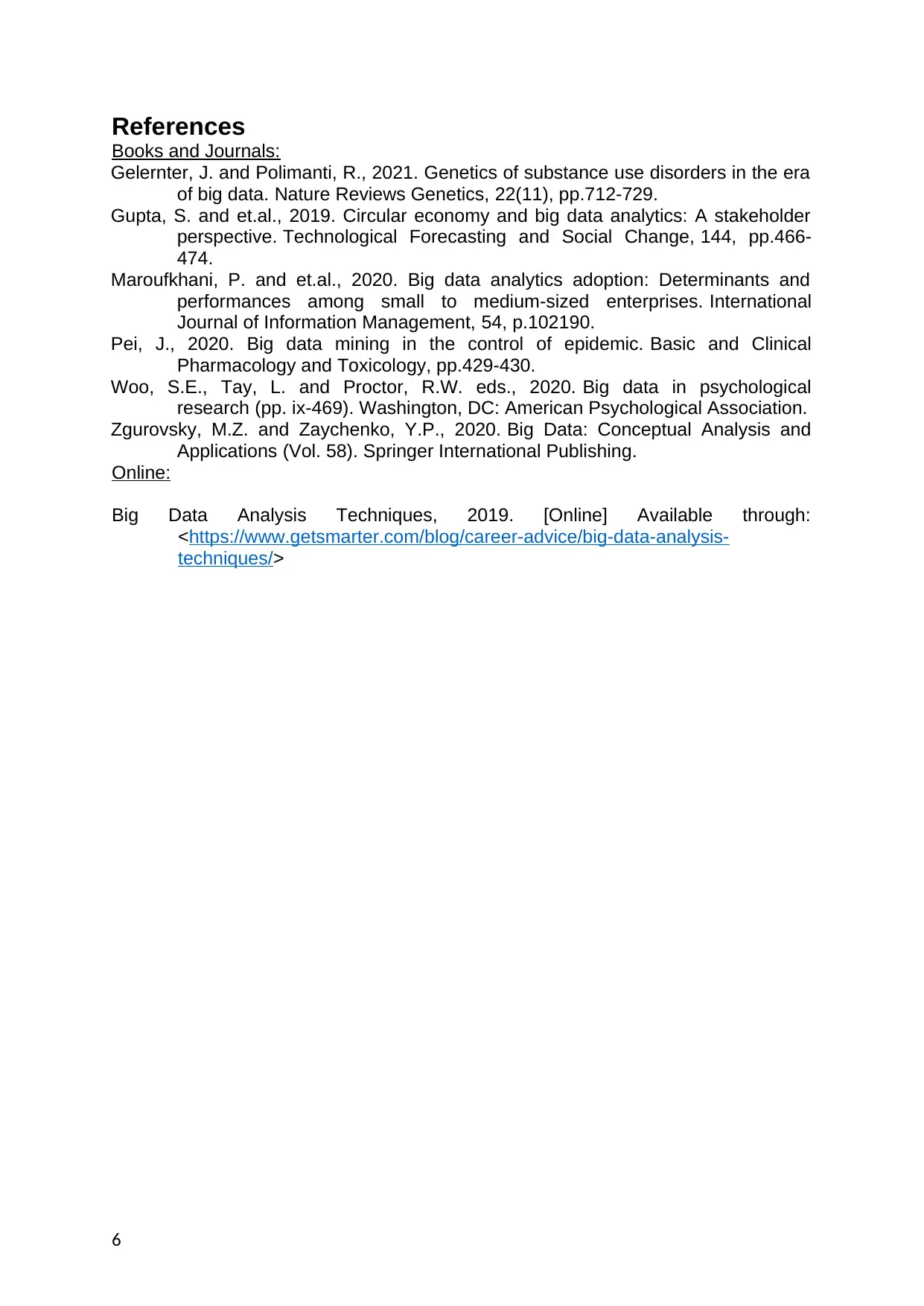
References
Books and Journals:
Gelernter, J. and Polimanti, R., 2021. Genetics of substance use disorders in the era
of big data. Nature Reviews Genetics, 22(11), pp.712-729.
Gupta, S. and et.al., 2019. Circular economy and big data analytics: A stakeholder
perspective. Technological Forecasting and Social Change, 144, pp.466-
474.
Maroufkhani, P. and et.al., 2020. Big data analytics adoption: Determinants and
performances among small to medium-sized enterprises. International
Journal of Information Management, 54, p.102190.
Pei, J., 2020. Big data mining in the control of epidemic. Basic and Clinical
Pharmacology and Toxicology, pp.429-430.
Woo, S.E., Tay, L. and Proctor, R.W. eds., 2020. Big data in psychological
research (pp. ix-469). Washington, DC: American Psychological Association.
Zgurovsky, M.Z. and Zaychenko, Y.P., 2020. Big Data: Conceptual Analysis and
Applications (Vol. 58). Springer International Publishing.
Online:
Big Data Analysis Techniques, 2019. [Online] Available through:
<https://www.getsmarter.com/blog/career-advice/big-data-analysis-
techniques/>
6
Books and Journals:
Gelernter, J. and Polimanti, R., 2021. Genetics of substance use disorders in the era
of big data. Nature Reviews Genetics, 22(11), pp.712-729.
Gupta, S. and et.al., 2019. Circular economy and big data analytics: A stakeholder
perspective. Technological Forecasting and Social Change, 144, pp.466-
474.
Maroufkhani, P. and et.al., 2020. Big data analytics adoption: Determinants and
performances among small to medium-sized enterprises. International
Journal of Information Management, 54, p.102190.
Pei, J., 2020. Big data mining in the control of epidemic. Basic and Clinical
Pharmacology and Toxicology, pp.429-430.
Woo, S.E., Tay, L. and Proctor, R.W. eds., 2020. Big data in psychological
research (pp. ix-469). Washington, DC: American Psychological Association.
Zgurovsky, M.Z. and Zaychenko, Y.P., 2020. Big Data: Conceptual Analysis and
Applications (Vol. 58). Springer International Publishing.
Online:
Big Data Analysis Techniques, 2019. [Online] Available through:
<https://www.getsmarter.com/blog/career-advice/big-data-analysis-
techniques/>
6
⊘ This is a preview!⊘
Do you want full access?
Subscribe today to unlock all pages.

Trusted by 1+ million students worldwide
1 out of 6
Related Documents
Your All-in-One AI-Powered Toolkit for Academic Success.
+13062052269
info@desklib.com
Available 24*7 on WhatsApp / Email
![[object Object]](/_next/static/media/star-bottom.7253800d.svg)
Unlock your academic potential
Copyright © 2020–2025 A2Z Services. All Rights Reserved. Developed and managed by ZUCOL.


